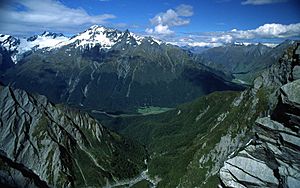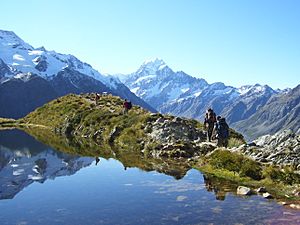Protected areas of New Zealand facts for kids

Protected areas of New Zealand are special places that are kept safe to protect their nature, history, or culture. The way they are protected and why can change depending on how important the area is. It also depends on if the land is owned by the public or by private people. Almost 30 percent of New Zealand's land is owned by the public and has some kind of protection. These areas include conservation parks, island reserves, marine reserves, and national parks.
History of Protected Areas
Back in 1840, the leader of New Zealand, Governor Hobson, was told to set aside some land. This land was to be used by everyone for things like public health, fun, and convenience. Over the years, many laws were made to help protect more and more land. These laws made it possible to create parks and reserves. The main law used today is the Reserves Act 1977.
Types of Protected Areas in New Zealand
The Department of Conservation (DOC) looks after most of the public land in New Zealand. This land is protected for its beautiful scenery, scientific value, history, and culture. It is also set aside for people to enjoy outdoor activities. DOC manages nearly 30 percent of the country's total land area. The main law that guides this work is the Reserves Act 1977.
New Zealand has 13 national parks. These parks cover almost 28,900 square kilometers. There are also over 50 Conservation Parks, about 3,500 reserves, and some protected private land. DOC also works to protect wildlife. They manage 19 marine reserves and two other protected areas in the ocean. These stretch from the Kermadec Islands to Fiordland.
If someone wants to build something in a Coastal Marine Area, they need special permission. These areas include the coast and up to one kilometer up rivers. This permission is called a Resource Consent. It is needed under the Resource Management Act 1991.
Conservation Parks
Conservation Parks are protected areas that keep their natural and historic features safe. They also allow people to enjoy recreation and outdoor activities. Before 1987, many of these were called Forest Parks. Now, they are all known as Conservation Parks.
- Ahuriri Conservation Park
- Aorangi Forest Park
- Aotea Conservation Park
- Catlins Conservation Park
- Coromandel Forest Park
- Craigieburn Forest Park
- Eyre Mountains/Taka Ra Haka Conservation Park
- Hakatere Conservation Park
- Hanmer Conservation Park
- Hāwea Conservation Park
- Ka Whata Tu O Rakihouia Conservation Park
- Kaimai Mamaku Conservation Park
- Kaimanawa Forest Park
- Kaweka Forest Park
- Korowai/Torlesse Tussocklands Park
- Lake Sumner Forest Park
- Mavora Lakes Conservation Park
- Mt Richmond Forest Park
- Nga Motu / Sugar Islands Conservation Park
- North-west Nelson Forest Park
- Northland Conservation Park
- Oteake Conservation Park
- Pirongia Forest Park
- Pureora Forest Park
- Raukumara Conservation Park
- Remutaka Forest Park
- Ruahine Forest Park
- Ruataniwha Conservation Park
- Tararua Forest Park
- Te Kahui Kaupeka Conservation Park
- Te Papanui Conservation Park
- Victoria Forest Park
- Whakarewarewa Conservation Park
- Whirinaki Te Pua-a-Tāne Conservation Park
Island Reserves
These are islands located off the coast. They are set aside by groups like the Department of Conservation. They act as safe places for New Zealand's unique native plants and animals.
- Blumine Island
- The Brothers Islands
- Codfish Island
- Kapiti Island
- Little Barrier Island
- Mana Island
- Maud Island
- Matiu / Somes Island
- Motutapu Island
- Poor Knights Islands
- Rangitoto Island
- Resolution Island
- Stephens Island
- Stewart Island / Rakiura
- Tiritiri Matangi Island
- Ulva Island
- Whakaari / White Island
Mainland Islands
The Department of Conservation has created five special areas on the mainland called "mainland islands." These are fenced or managed areas that act like islands. They keep out pests to protect native species.
- Boundary Stream Mainland Island
- Paengaroa Mainland Island
- Rotoiti Mainland Island
- Te Urewera Mainland Island
- Trounson Kauri Park Mainland Island
Marine Reserves
New Zealand has over three dozen marine reserves. These are spread around the North and South Islands. Two are on far-off island groups. The very first marine reserve was created in 1975. These areas protect ocean life and habitats.
National Parks
There are 13 national parks in New Zealand. They cover a huge area, almost 25,000 square kilometers. These parks are known for their stunning landscapes and important natural features.
- Abel Tasman National Park
- Aoraki / Mount Cook National Park
- Arthur's Pass National Park
- Egmont National Park
- Fiordland National Park
- Kahurangi National Park
- Mount Aspiring National Park
- Nelson Lakes National Park
- Paparoa National Park
- Rakiura National Park
- Te Urewera National Park (former)
- Tongariro National Park
- Westland Tai Poutini National Park
- Whanganui National Park
National Reserves
A national reserve is a special area that is very important to the whole country. Some of these reserves protect historical sites. Others protect important natural areas.
Regional Parks
Regional parks in New Zealand are managed by local councils in different regions. They offer places for recreation and protect local natural areas.
Scenic Reserves
Scenic reserves are the most common type of protected area in New Zealand. Most of them are quite small. Many are less than one square kilometer. These reserves often protect beautiful areas of native forest near roads.
Esplanade Reserves
Esplanade Reserves are strips of land found next to the sea, rivers, and lakes. When they were first created, they were usually 20 meters wide. These reserves help protect nature along waterways. They also allow people to access the water, as long as it doesn't harm the environment.
Local Reserves
Local reserves are created for many different reasons. They can be for things like parks, playgrounds, or even to protect water sources. They cover a wide range of uses, not just for nature protection.
Wetlands
New Zealand is part of an international agreement called the Ramsar Convention. This agreement helps protect important wetlands around the world. As of 2008, New Zealand has six Ramsar-registered wetland sites:
- Farewell Spit
- Firth of Thames
- Kopuatai Peat Dome
- Manawatu River mouth and estuary
- Awarua Wetland
- Whangamarino
Travis Wetland in Christchurch is a project to bring a wetland back to life. It was bought by the city council to be a nature reserve.
World Heritage Sites
There are three World Heritage Sites in New Zealand. These are places recognized by UNESCO as having outstanding universal value.
- Te Wahipounamu
- Tongariro National Park
- New Zealand Subantarctic Islands
Private Reserves
Some protected areas are owned and managed by private groups or individuals. An example is:
- Hinewai Reserve
Other Protected Areas
New Zealand has other important protected areas, including:
- JM Barker (Hapupu) Historic Reserve
- Zealandia (wildlife sanctuary), Wellington
- Maungatautari Restoration Project
- Mount Tutu Eco-Sanctuary
- Nugget Point
- Orokonui Ecosanctuary
- Lake Rotokare, Taranaki
- Brook Waimarama Sanctuary
See also
 In Spanish: Áreas protegidas de Nueva Zelanda para niños
In Spanish: Áreas protegidas de Nueva Zelanda para niños


